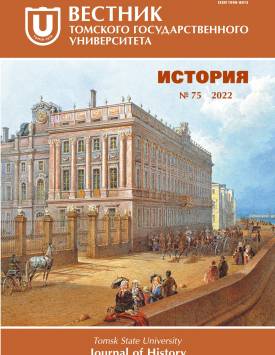Topography and planigraphy of the Kashtak fortress: experience of complex historical and archaeological research
The article is devoted to the reconstruction of the Kashtak prison, built in 1697 to protect the first complex in the history of Russia for the extraction of silver ore and silver smelting. In case of success, it would acquire the strategic importance of financial support for the reforms, and therefore was under the personal control of Peter the Great. Recently, historians V.N. Dobzhansky and A.N. Ermolaev (Kemerovo) collected, systematized and translated all available written sources on the history of the Kashtak silver-smelting industry. For the most part, this is an official correspondence (reports, instructions and decrees) with the participation of the head of servicemen in the Kashtak fortress S. Lavrov, the Greek miner Alexander Levandian, the Tomsk governor V.A. Rzhev, Siberian Order and Peter I personally. Bergmeister N. Kleopin's notes on the inspection of the fortress’s remains in 1744 are also an important written source. However, written sources do not answer the questions of the exact size of the fortress, its topography and internal planigraphy and the topography and planigraphy of the entire mining industry. Answers to these questions became possible after conducting archaeological reconnaissance in May 2017, which included, among other things, a professional topographical survey of the superbly preserved microrelief at the site of the fortress itself and some of the ore mines. The article presents the results of a comparison of data from archeology and written history. It was found that the fortified part of the fortress was confined to the mouth of the head-shaped section formed by the first terrace above the floodplain of the left bank of the r. Kashtak (Big Kashtak) and the right bank of the r. Small Kashtak. The remains of the defensive moat are fixed on a flat platform, no more than 4 m high above the water edge in the river Kashtak, with a distance to the channel about 25-40 m. This does not contradict fragmentary information from written sources, but substantially complements them. Such topography of the settlement in the end of the XVII - beginning of the XVIII centuries fully met the requirements of the military protection of ore mines in terms of accommodating a large number of servicemen and workers. The corners of the moat are oriented to the cardinal points. The line of the moat connecting the opposite corners of the fortress is slightly inward on each side, therefore the corners of the platform slightly protrude forward. There is no rampart as such, rather remnants of the breastwork on the inner side of the moat. The length of the north-east side was 49,4 m, the south-east side was 46,5 m, the south-west side was 47,9 m, the north-west side was 51,3 m. The area of the fortified site is about 2400 square meters. The actual difference with the data of written sources on the total length of the walls (more than 23 m) explains S. Lavrov's previously incomprehensible replies about how he “completed the fortress for twelve sazhen...” 8 sinkholes were fixed inside the fortress, with two more on the outer side of the moat. Relatively precise (after correlation with the description of S. Lavrov) identification of a number of structures within the ostrog (anbar, Greek corner, earthwork yurts) indicated a pattern of their location along the walls of the ostrog, leaving the central space free of deep-earth structures. Probably the ground forge facilities were located in the center. The remains of ore mines near the fortress have been determined. Their fixed location does not contradict the written information and data of the drawing from the S.U. Remezov’s “Horographic Drawing Book”, but clarifies it in terms of exact distances.
Keywords
topography, planigraphy, the first silver-smelting complex of Russia, Kashtak fortress, north-eastern foothills of the Kuznetsk AlatauAuthors
| Name | Organization | |
| Marochkin Alexey G. | Federal Research Center of Coal and Coal Chemistry of Siberian Branch of the Russian Academy of Sciences | comcon@yandex.ru |
| Sizyov Alexander S. | Federal Research Center of Coal and Coal Chemistry of Siberian Branch of the Russian Academy of Sciences | asizyov@list.ru |
| Ermolaev Alexey N. | Federal Research Center of Coal and Coal Chemistry of Siberian Branch of the Russian Academy of Sciences | al-ermolaev@yandex.ru |
| Plats Ivan A. | Federal Research Center of Coal and Coal Chemistry of Siberian Branch of the Russian Academy of Sciences | ivanplac@yandex.ru |
References

Topography and planigraphy of the Kashtak fortress: experience of complex historical and archaeological research | Tomsk State University Journal of History. 2022. № 75. DOI: 10.17223/19988613/75/21
